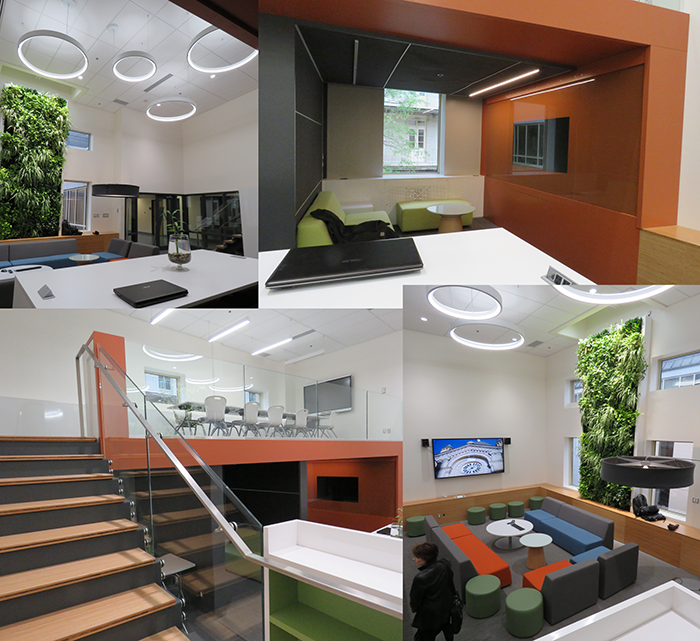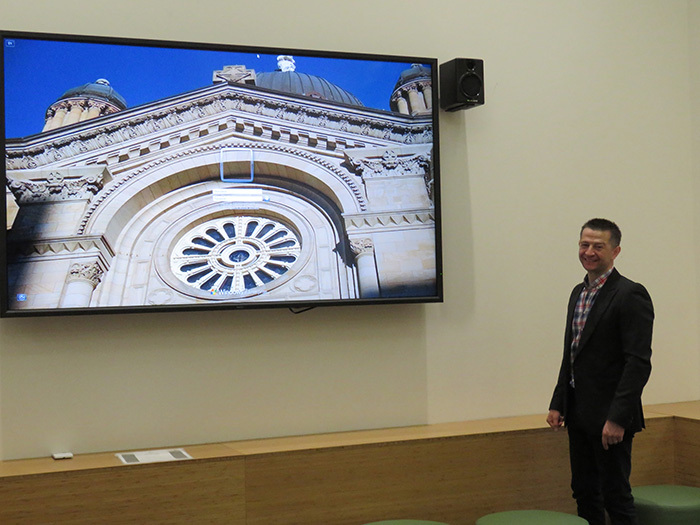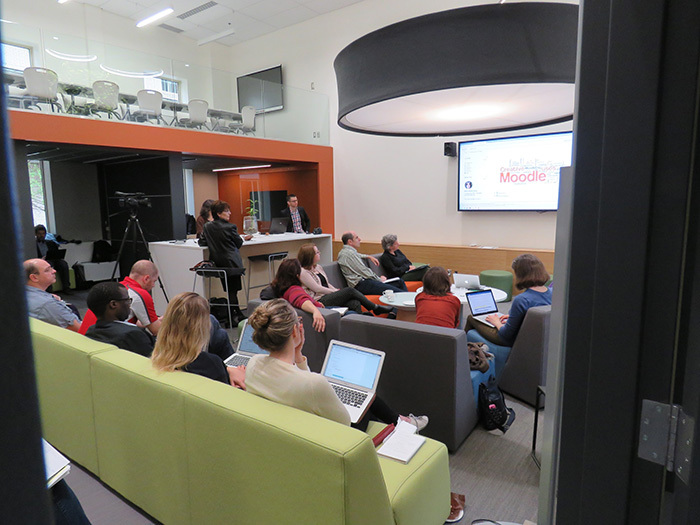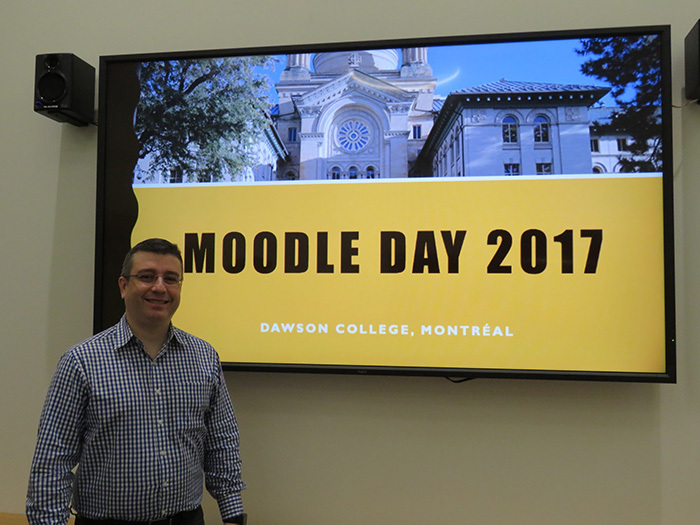Moodle Day 2017: Sharing Practices
On Friday May 26th 2017, Dawson College’s Conference Room 3F.43, also known as the CoLab, was the site of a well-received and well-attended professional development activity. Teachers from a number of English colleges, universities and Ministerial IT Partners converged on the space for Moodle Day 2017 – an event organized by DECClic’s English Sector Consultant, Roman Barba and Dawson College’s IT Representative, Rafael Scapin.

Different views of Dawson College’s CoLab.
Off to a Good Start
The event attracted a variety of stakeholders from Higher Education in the Montreal area. The day began with a light breakfast, which attendees used to exchange ideas and network from the get go. This created a nice buzz to get the event started!
Shortly after 9:00 a.m., Roman Barba from DECclic said a few opening words of welcome to thank the attendees for making the trip to Dawson for the event. Moodle Day has become an important annual occasion for professional development and sharing of best practices.

Roman Barba, DECClic’s English Sector Consultant co-organized the event and acted as MC for the day.
The first talk, entitled Creative Uses of Moodle, was led by Anna Sokolovskaya from Concordia University’s Instructional and Information Technology Services. She shared a number of her tips that she uses when she works directly with teachers who are using Moodle at Concordia. One of the first things she does is to ask the teachers to think about how they can simplify the structure and presentation of their courses so that they are more user-friendly for students. She recommends removing unnecessary Moodle ‘blocks’ from their courses, and to make sure that all the blocks are either on the left or the right side of the course content, which maximizes the space available for the most important information on the screen.
Anna covered a number of other topics:
- Using ‘Labels’ to keep things organized
- Avoiding what she calls ‘the toilet roll effect’ (continuous scrolling of pages and pages of content)
- Using Moodle’s HTML blocks in a variety of ways (adding a picture and biography to the course to add a human touch to the learning environment)
- Using an Activity block to help students stay organized and quickly reference what they are responsible for in the short term
- Using the Glossary function in unique ways (ex. creating a ‘get to know you’ area of the course by adding student names with descriptions instead of glossary terms and definitions)
- Creating personal journal areas using the discussion forum (by assigning each student to their own group so that only they can see what they are posting in the forum)
Anna also reminded the Moodle Day participants that it is best not to put too many dates in your Moodle course if you want to reuse it from year to year!

A number of attendees from the college network and some English universities appreciated the opportunity to share best practices
The next presenter was Patricia M. Campbell, a teacher from the Computer Science department at Dawson College. Her presentation, entitled Course in the Cloudelicited a fair amount of enthusiasm from the attendees, since she showed a variety of ways to embed documents and rich media within Moodle, including Office 365 and Google Docs documents. It was interesting to see both PowerPoint slide decks and Word Documents embedded directly within Moodle! Instead of updating files on her computer from year to year and then uploading them to Moodle, Patricia now creates links within Moodle to cloud-based documents that she updates as needed – an important innovation, since the technologies she teaches are constantly evolving.

A visual representation of the different technologies Patricia M. Campbell links to in Moodle (Source: Patricia M. Campbell)
Patricia also pointed out that many of us would like to use rich media in our Moodle courses, but our Moodle servers have imposed quotas that restrict us from uploading large files, or the server performance is not high enough to stream this media. Posting to YouTube or other media servers, then embedding the video within Moodle is an excellent solution to this issue, and can be accomplished by pasting IFRAME sharing code that YouTube and others provide on the page of each video. Patricia’s presentation was created with Google Slides>.
After a short break with another burst of enthusiastic networking, Vanier College’s IT-Representative Patti Kingsmill presented her talk entitled Working with Settings of the Moodle Gradebook: A Case Study. Patti shared that she was relatively new to Moodle and was searching for solutions to a particular issue with regards to evaluations within the Respiratory and Anaesthesia Technology program, which has a national accreditation exam. She described how she was able to solve a complex approach to formative and summative evaluations and the inclusion of choice for students with regards to these evaluations. Patti was able to work out a plan to get all of the parts working together properly in Moodle’s Gradebook, with some support from Jean-Paul and Roman at DECclic. While the solution was quite ingenious, it would require a whole stand-alone Profweb article to explain! Patti’s case study is an excellent example of both her perseverance and how Moodle’s limits can be stretched with a little ingenuity.

Remote attendees of Moodle Day 2017 were able to view presentations through the BigBlueButton open source web conferencing platform
Next up was Roxanne Millette from John Abbott College who presented The Question Sharer Option and the Book Resource. Roxanne shared her experience using 2 features that she discovered since last year’s Moodle Day. Roxanne related how the ‘Book’ resource in Moodle allows teachers to set up information as ‘chapters.’ Adding to Moodle courses from week to week can result in having a long scrolling page of activities and entries that can be a bit daunting to navigate by the end of the semester. Using the Book resource not only makes content easier to find, it has the added advantage of automatically adding navigation within the course content (links to previous and next entries).
Next Roxanne spoke about how the ‘Question sharer’ option in Moodle (which needs to be activated by the Moodle administrator) has made her work a bit more simple. She used to spend a lot of time exporting and importing quiz questions between the 3 different sections of her courses. With the Question sharer option activated, she can now simply draw on a database of all her questions and use them between the different sections – a real time-saver!
The Moodle Day presentations ended on a high note with Dominique Robertson from the McGill University Health Centre. She provided a fun and creative presentation entitled MOODLE NOODLES?. With a healthy dose of humour, she spoke about her challenge to implement Moodle in the wake of a decision by the administration to stop offering face-to-face workshops to nurses following a round of budget cuts. Her presentation title refers to how she unravelled the ‘spaghetti’ of using the Moodle platform within a context where there are many rules about privacy and protecting patient confidentiality. Since there is an obligation to report the attendance, progress and results of the training for nurses to the government, Dominique had to find solutions that allowed her to collect data. She told the participants that she uses the Storyline authoring software to create SCORM packages that are able to report a variety of information to Moodle (such as average module completion time) while also providing a rich media experience (with custom playback controls) and the ability to have integrated quizzes.
As part of her own learning about Moodle, Dominique recommended resources that she has used on her own personal Moodle journey like Oliver Schinkten’s Moodle tutorials on Lynda.com and the FacultyWorkshopTV channel on YouTube. She was also very enthusiastic about Moodle’s own YouTube channel.

Rafael Scapin, Dawson College’s IT-Representative co-organized Moodle Day 2017.
A Fine Moodle Day Denouement
Roman Barba offered a few closing words of thanks to the attendees and to Dawson College for hosting the event, and then invited everyone to stay for a reception. With so many inspiring presentations and Moodle enthusiasts on-hand, there were lively exchanges, and the reception even went a full hour past its scheduled completion!
Congratulations and thanks to DECClic and Dawson College for organizing this inspiring day of sharing!

